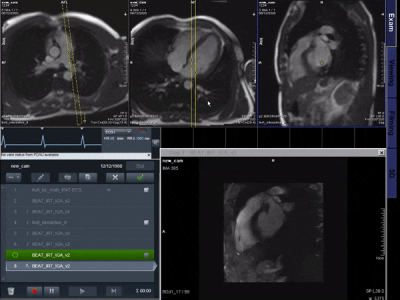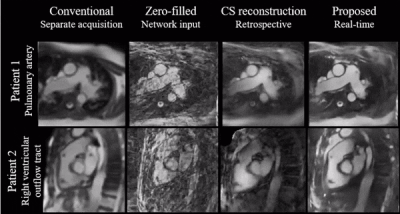Olivier Jaubert1,2, Javier Montalt-Tordera2, Dan Knight2,3, Gerry J. Coghlan2,3, Simon Arridge1, Jennifer Steeden2, and Vivek Muthurangu2
1Department of Computer Science, UCL, London, United Kingdom, 2Centre for Cardiovascular Imaging, UCL, London, United Kingdom, 3Department of Cardiology, Royal Free London NHS Foundation Trust, London, United Kingdom
1Department of Computer Science, UCL, London, United Kingdom, 2Centre for Cardiovascular Imaging, UCL, London, United Kingdom, 3Department of Cardiology, Royal Free London NHS Foundation Trust, London, United Kingdom
A deep learning based framework using a 2D recurrent
residual U-Net trained on multiple orientations is proposed to reconstruct an
interactively acquired bSSFP tiny golden angle radial sequence for catheter
guidance in patients.

Figure
5. Animation. Proof of concept interactive acquisition in a healthy subject. Changes of orientations are performed interactively both abruptly
and through continuous motion between RVOT, PA and SAX. Short transition
periods can be observed before convergence to good image quality.

Figure
4. Animation. Pulmonary artery (top) and right ventricular outflow tract (bottom) views in
two different catheterized patients where the balloon can be seen. The videos are shown for the conventional
scan, the gridded images (input to the network), retrospective compressed
sensing reconstruction (CS with temporal TV regularization) and proposed real
time images.